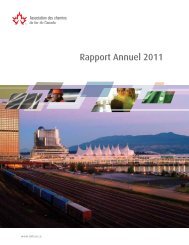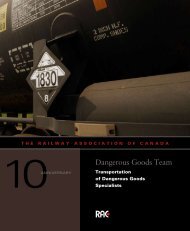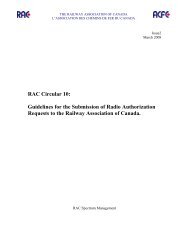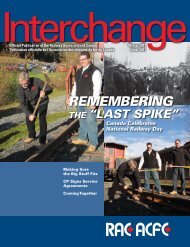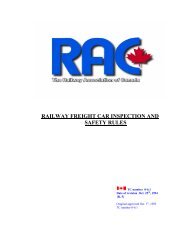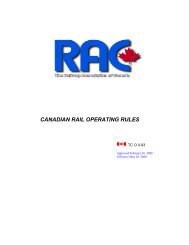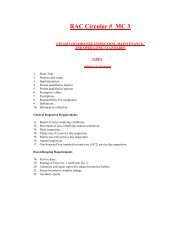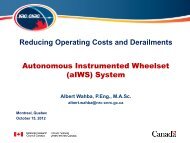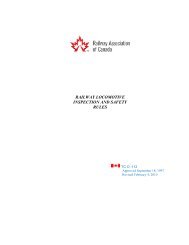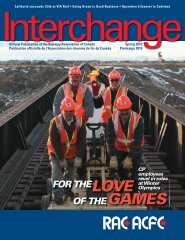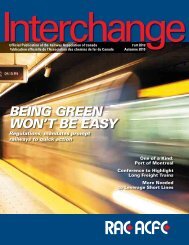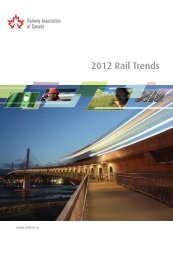Locomotive Emissions Monitoring Program - Railway Association of ...
Locomotive Emissions Monitoring Program - Railway Association of ...
Locomotive Emissions Monitoring Program - Railway Association of ...
Create successful ePaper yourself
Turn your PDF publications into a flip-book with our unique Google optimized e-Paper software.
operation <strong>of</strong> longer trains in 2008. New higher horsepower locomotives were employed to move the longer trainsets.<br />
In 2008, GO Transit suspended use <strong>of</strong> the proprietary FTC fuel extender additive pending resolution <strong>of</strong> warranty<br />
concerns on its new locomotives. Also, the additional scheduling that came online in 2008 resulted in greater<br />
capacity within the commuter rail system. This combination <strong>of</strong> events negatively impacted the GHG intensity level.<br />
Generally, when additional service routes are introduced it takes a period <strong>of</strong> time to increase ridership to fill new<br />
capacity. As new capacity is utilized, it is expected that GHG intensity levels will decrease.<br />
CAC <strong>Emissions</strong> Intensity: NOx emission intensity in 2008 for all freight operations was 0.27 kg per 1,000 RTK, the<br />
same as for 2007.<br />
Tropospheric Ozone Management Areas (TOMA): Of the total Canadian rail sector fuel consumed and corresponding<br />
GHG emitted in 2008, 2.8 per cent was used in the Lower Fraser Valley <strong>of</strong> British Columbia, 17.1 per cent in the<br />
Windsor-Quebec City Corridor and 0.2 per cent in the Saint John area <strong>of</strong> New Brunswick. Similarly, NOx emissions for<br />
the three TOMA were, respectively, 2.8 per cent, 16.8 per cent and 0.2 per cent.<br />
<strong>Emissions</strong> Reduction Initiatives by <strong>Railway</strong>s: During 2008, the railways continued to acquire new locomotives<br />
compliant with U.S. EPA Tier 2 emissions standards (which came into force January 1st, 2005). These new locomotives<br />
are factory-fitted with AESS systems to minimize idling. Upon remanufacture, older locomotives are fitted with APU<br />
units. As <strong>of</strong> 2008, 39.1 per cent <strong>of</strong> the locomotive fleet has been fitted with AESS or APU devices.<br />
In 2008, CP announced that, assisted by Transport Canada’s ecoFREIGHT <strong>Program</strong>, it will test two GenSet<br />
locomotives in southern Ontario road switching service. The motive power <strong>of</strong> GenSet locomotives consists <strong>of</strong> three<br />
independent 700 horsepower diesel engine generating sets (instead <strong>of</strong> one 2,000 horsepower diesel engine) which<br />
are activated incrementally to supply the traction horsepower required. Overall, the technology aims to achieve<br />
significant fuel savings, ultra-low emissions and longer engine life.<br />
Staff training and incentives focussing on fuel conserving train-handling procedures were accelerated. Nonlocomotive<br />
equipment initiatives to reduce fuel consumption and, hence, emissions included acquisition <strong>of</strong> additional<br />
higher-capacity freight cars and lower-weight aluminium gondola units. Further, operational fluidity improvements<br />
were implemented which included infrastructure upgrades, wheel-flange lubrication, top-<strong>of</strong>-rail friction control and<br />
the benefits <strong>of</strong> co-production arrangements between the Class I freight railways, CN and CP, for shared operation on<br />
mainline segments. In 2008, ultra-low sulphur diesel (ULSD) fuel was standardized on VIA Rail Canada and commuter<br />
operations. The Canadian railways are monitoring field testing on U.S. railway locomotives <strong>of</strong> prototype diesel<br />
oxidation catalysts and diesel particulate filters to reduce CAC emissions. Such devices require ULSD fuel and may<br />
become part <strong>of</strong> the locomotive technology needed to meet future more stringent U.S. EPA emissions limits.<br />
RAC Awareness Generation Actions Aimed at <strong>Emissions</strong> Reduction:<br />
The RAC provides a venue for the railway companies to exchange ideas and best operating practices for reducing<br />
emissions associated with railway activities. The RAC is in frequent communication with its members, through<br />
newsletters, E-mail distribution, working committees, RAC member events, the RAC Annual General Meeting and<br />
through the RAC website. As such, the RAC distributes relevant information within its membership regarding<br />
technologies and operating practices that reduce emissions, particularly GHGs, on an activity basis. Similarly, to<br />
assist shippers and other concerned parties to know difference in emissions level, on a shipment-by-shipment basis,<br />
between choosing the rail versus truck mode, the RAC initiated development <strong>of</strong> an on-line Rail Freight Greenhouse<br />
Gas Calculator. The Calculator is now available by accessing www.railcan.ca/site_ghg_calculator .<br />
To further emphasize awareness about environmental concerns, the RAC sponsors an annual Environmental Award<br />
<strong>Program</strong> for both passenger and freight railways operating in Canada. The objective <strong>of</strong> the program is to share<br />
and assess initiatives undertaken by railways to improve their environmental performance. Also, to further spread<br />
such information to its member railways, the RAC participated in the 2008 Rail Conference ‘On Board for a Cleaner<br />
Environment’ May 6-7 in Toronto convened by Transport Canada’s ecoFREIGHT program. The presentations can be<br />
viewed on www.ecoaction.gc.ca/ec<strong>of</strong>reight.<br />
v LEM 2008





